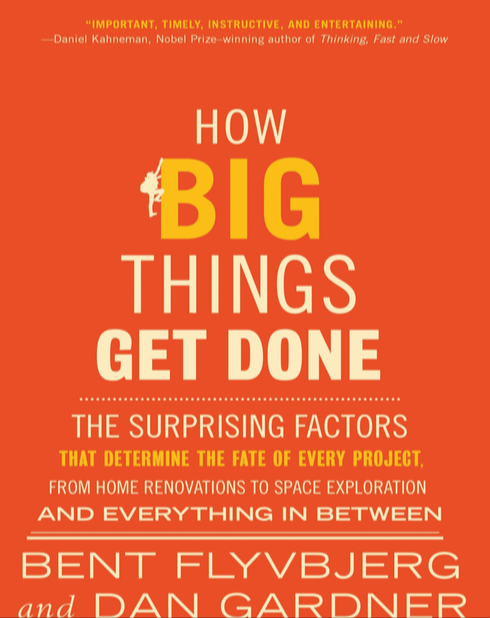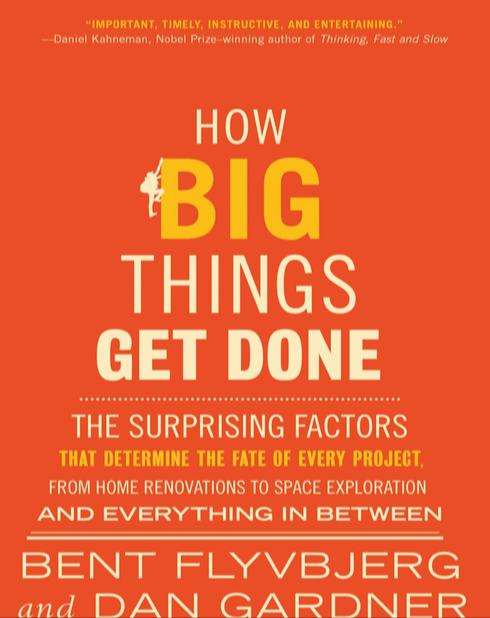How Big Things Get Done: The Surprising Factors That Determine the Fate of Every Project, from Home Renovations to Space Exploration and Everything In Between | Bent Flyvbjerg - Dan Gardner
![]()
Bent Flyvbjerg Dan Gardner Business Project Management Business Decision Making Decision-Making & Problem Solving Urban Planning & Development Occupational & Organizational Psychology Occupational & Organizational Popular Psychology Business Project Management Management & Leadership
- درباره کتاب
- بخشی از کتاب
- نظرات
The secrets to successfully planning and delivering projects on any scale—from home renovation to space exploration—by the world’s leading expert on megaprojects
“This book is important, timely, instructive, and entertaining. What more could you ask for?”—Daniel Kahneman, Nobel Prize–winning author of Thinking, Fast and Slow
“Over-budget and over-schedule is an inevitability. Incompetence and grift is outrageous. Bent Flyvbjerg, with this terrific data-driven book, has shown that there is another way.”—Frank Gehry
Nothing is more inspiring than a big vision that becomes a triumphant, new reality. Think of how the Empire State Building went from a sketch to the jewel of New York’s skyline in twenty-one months, or how Apple’s iPod went from a project with a single employee to a product launch in eleven months.
These are wonderful stories. But most of the time big visions turn into nightmares. Remember Boston’s “Big Dig”? Almost every sizeable city in the world has such a fiasco in its backyard. In fact, no less than 92% of megaprojects come in over budget or over schedule, or both. The cost of California’s high-speed rail project soared from $33 billion to $100 billon—and won’t even go where promised. More modest endeavors, whether launching a small business, organizing a conference, or just finishing a work project on time, also commonly fail. Why?
Understanding what distinguishes the triumphs from the failures has been the life’s work of Oxford professor Bent Flyvbjerg, dubbed “the world’s leading megaproject expert.” In How Big Things Get Done, he identifies the errors in judgment and decision-making that lead projects, both big and small, to fail, and the research-based principles that will make you succeed with yours. For example:
• Understand your odds. If you don’t know them, you won’t win.
• Plan slow, act fast. Getting to the action quick feels right. But it’s wrong.
• Think right to left. Start with your goal, then identify the steps to get there.
• Find your Lego. Big is best built from small.
• Be a team maker. You won’t succeed without an “us.”
• Master the unknown unknowns. Most think they can’t, so they fail. Flyvbjerg shows how you can.
• Know that your biggest risk is you.
Full of vivid examples ranging from the building of the Sydney Opera House, to the making of the latest Pixar blockbusters, to a home renovation in Brooklyn gone awry, How Big Things Get Done reveals how to get any ambitious project done—on time and on budget.
Editorial Reviews
Review
“Ignore [this book] at your peril.”—Peter Coy, The New York Times
“[How Big Things Get Done is] a book that every legislator, city council member and corporate executive ought to read.”—The Wall Street Journal
“Having researched the properties of planning errors, I am confident that nobody has studied the topic more broadly and deeply than Bent Flyvbjerg. His focus ranges from the Olympic Games to the renovation of your doghouse.”—Nassim Nicholas Taleb, distinguished professor of risk engineering at the NYU Tandon School of Engineering, and author of the Incertoseries
“A wise, vivid, and unforgettable combination of inspiring storytelling with decades of practical research and experience . . . Everyone who deals with large projects is already desperate to read this book. The rest of us will take great pleasure in learning from it anyway.”—Tim Harford, author of The Data Detective
“This book distills the best scientific advice on planning big projects. And it is arguably the bargain of the century. For a few dollars you can tap into thousands of dollars’ worth of insights in executive-education classrooms—and if you happen to be a CEO or head of state, the savings will quickly run into the billions.”—Philip E. Tetlock, co-author of Superforecasting
“How Big Things Get Done is not based on mere anecdotes; it distills decades of systematic research from more than sixteen thousand projects worldwide. The result is a crystal-clear pattern of surprising reasons why almost all big human projects fail to deliver as expected—and a road map for the book’s lucky readers to avoid them.”—Ola Rosling, CEO and co-founder of Gapminder; co-author of Factfulness
“If we’re to make it through these next few decades, we’re going to have to build a lot of stuff—and we’re going to have to do it cheaply and fast. Here’s a very useful handbook!”—Bill McKibben, author of The Flag, the Cross, and the Station Wagon
“Flyvbjerg’s study of big construction projects worldwide has led him to formulate the iron law of megaprojects: over budget, over time, under benefits, over and over again. His deep understanding of why big projects fail—and occasionally succeed—makes this book a truly fascinating read. There’s a practical payoff, too: a toolbox with eleven smart heuristics for better project leadership that every planner who wants to succeed should know.”—Gerd Gigerenzer, author of Gut Feelings
About the Author
Bent Flyvbjerg is the first BT Professor at Oxford University and the VKR Professor at the IT University of Copenhagen, an economist, and “the world’s leading megaproject expert,” according to global accounting network KPMG. He has consulted on over one hundred projects costing $1 billion or more and has been knighted by the Queen of Denmark.
Dan Gardner is a journalist and the New York Times bestselling author of Risk, Future Babble, and co-author of Superforecasting (with Philip E. Tetlock).










هنوز نظری ثبت نشده
اولین نفری باشید که نظر میدهید
ثبت نظر